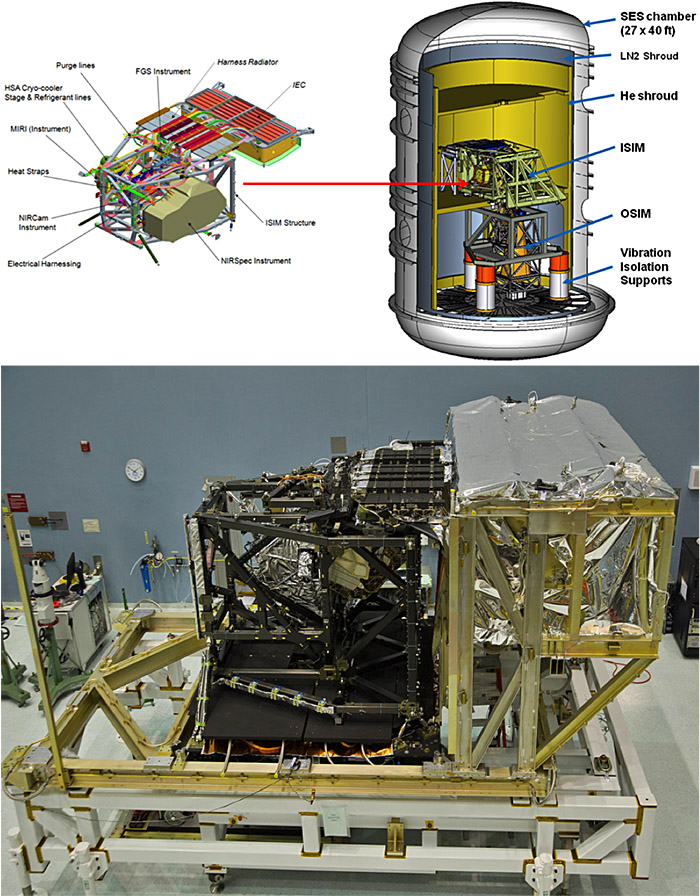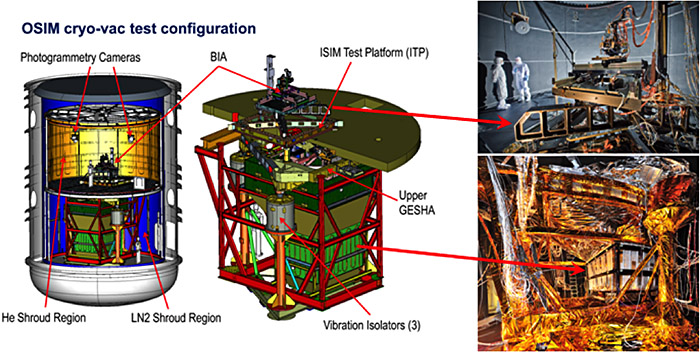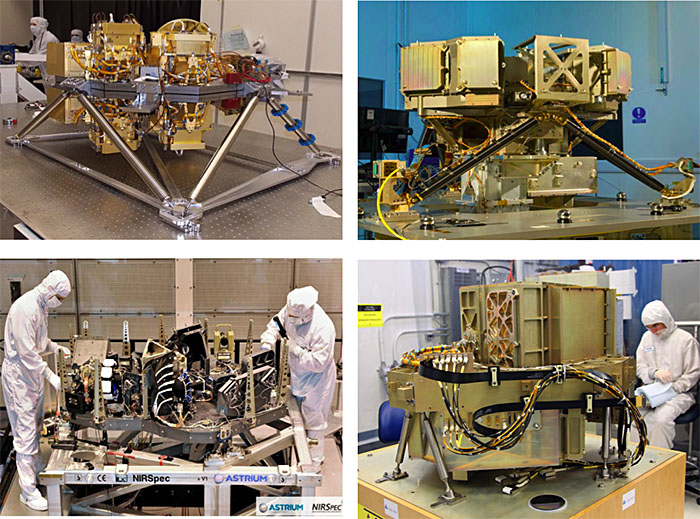Cryogenic Testing of JWST’s Instruments Under Way
Jason Kalirai Johns Hopkins APL
The Integrated Science Instrument Module (ISIM) is the science instrument payload of the James Webb Space Telescope (JWST). It is one of three system elements that, along with the telescope, sunshield, and spacecraft, comprise the JWST space vehicle1. At 1.4 metric tons, the ISIM accounts for approximately 20% of the JWST mass and consists of four science instruments, a fine guidance sensor, and nine other systems2. During August 2013, the ISIM began the first of three element-level space simulation chamber tests. Each of these tests will occur in the Space Environment Simulator (SES) at the Goddard Space Flight Center (GSFC) in Maryland and are the largest and most complex deep cryogenic tests that NASA has ever conducted. We call the first of these tests CV1-RR. During this test (Figure 1), the ISIM will be put through its paces using a high-fidelity simulator of the JWST telescope3.
Figure 1: The cryogenic portion of the ISIM system (top left and bottom) is shown in its test configuration (top right) for the CV1-RR test. A high-fidelity simulation of the JWST telescope beam is fed from below into the ISIM by an Optical SIMulator (OSIM) that is mounted on vibration isolators. The SES vacuum vessel is equipped with nitrogen and helium shrouds to enable testing at the 40K nominal flight operating temperature.
Prior to the delivery to ISIM integration, all of the individual systems and science instruments of the ISIM have completed flight qualification testing. The CV1-RR test will be the first time that these systems have functioned together at the ISIM-element level of assembly. This first test is a risk reduction (RR) activity made necessary by the test complexity. The ISIM configuration for the CV1-RR (Figure 2) will include two of four science instruments (NIRSS3 and MIRI4) but is otherwise complete.
Figure 2: The OSIM test configuration is shown (left) with a Beam Image Analyzer (BIA) in place of the ISIM. The BIA is an instrument package that is designed to verify the fidelity of the simulated telescope beam. Photographs (right) show the OSIM and BIA in the SES chamber. Note personnel at the upper right for scale.
The CV1-RR test will be followed by two cryogenic performance tests (CV2 and 3) that bracket an ambient temperature launch environment (vibration and acoustic) test. These subsequent tests, which will occur during spring of 2014 and 2015, will complete the full performance verification and flight qualification of the ISIM ahead of its delivery for integration with the telescope (at GSFC) during October 2015.
The NIRCam6 and NIRSpec7 instruments (Figure 3) have completed their instrument-level cryogenic testing, were both delivered to GSFC this summer, and are currently undergoing final preparations for integration into the ISIM ahead of the CV2 test.
Figure 3: The JWST science instruments. Clockwise from upper left: NIRCam, MIRI, FGS/NIRSS, and NIRSpec. All of the flight instrument have completed instrument-level flight qualification testing and have been delivered to GSFC for integration with the ISIM system.
JWST at AAS 223 and Tour the Goddard Space Flight Center
The JWST team will be at the January 2014 AAS meeting in Washington, DC, and we invite the community to several events to learn more about the status of JWST and future science opportunities. First, STScI will have a booth in the exhibit hall and will host a number of interactive sessions to get feedback from the community. This will include demonstrations of the NIRSpec microshutter array planning tool, demonstrations of future ETC-related tools to plan science observations, user surveys, and much more.
There will be two JWST-themed sessions at the AAS meeting, both on Wednesday, 8 January 2014. First, at 10 am, five speakers from the AAS will discuss future science opportunities with JWST in their respective research areas:
- Marla Geha (Yale University), Stellar Initial Mass Function
- John Johnson (Harvard University), Exoplanet Characterization
- Alicia Soderberg (Harvard University), Supernovae
- Matthew Tiscareno (Cornell University), Solar System
- Mark Wyatt (Cambridge University), Star and Planet Formation
Following the first special session, at 12:45 pm on 8 January, STScI will host a joint JWST and Hubble Town Hall meeting. The Town Hall will include a presentation on HST by Ken Sembach (STScI, HST Mission Head) and a presentation on JWST by Eric Smith (NASA, JWST Program Office). Following the two updates, recent Nobel laureate Adam Riess (STScI/JHU) will give a science talk related to dark energy.
In addition to the activities at the AAS meeting in Washington, DC, the JWST team is organizing a tour of NASA's Goddard Space Flight Center (GSFC) in Greenbelt, MD. GSFC is home to many NASA projects, including JWST. During the tours — scheduled for the morning and afternoon of Thursday, 9 January — AAS members will get an overview of GSFC, participate in a presentation on "Science on a Sphere", tour Goddard's Integration and Testing Facility, and witness JWST being built in the world's largest cleanroom. AAS members can register for one of the two tours at the same time as the general registration for the AAS meeting. Foreign nationals will have additional paperwork to complete, so we request that you send an email to [email protected] if you are a foreign national.
References:
[1] Greenhouse, M. A., et al., Proc SPIE, vol. 8860, 2013
[2] Lundquist, Ray, et al., Proc SPIE, vol. 8442, 2012
[3] Sullivan, Joe, et al., Proc SPIE, vol. 7731, 2010
[4] Doyon, Rene, et al., Proc SPIE, vol. 8442, 2012
[5] Wright, G., et al., Proc SPIE, vol. 7731, 2010
[6] Beichman, C. A., et al., Proc. SPIE, 8442, 2012
[7] Ferruit, P., et al., Proc. SPIE, 8442, 2012
Note: This article was co-authored by Matt Greenhouse, Project Scientist for the JWST Science Instrument Payload at NASA's Goddard Space Flight Center.




